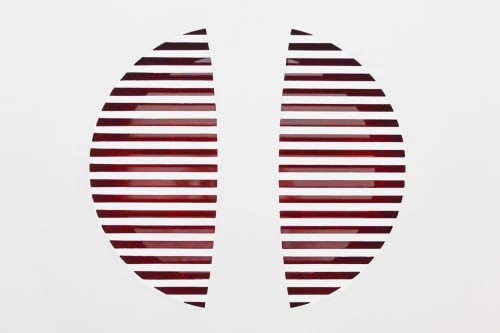In her first solo show in California, Israeli-born, New York-based artist Naama Tsabar interposes form and gender performance history in her elegant installation of functional sculptures in Inversions, on view at Shulamit Nazarian Gallery through February 29. On February 11 & 12, Naama Tsabar along with Nicki Chen-Walters, Diana Diaz, FIELDED, Kristin Mueller, and Sarah Strauss will perform works from the exhibit, in tandem with their presence at Frieze Art Fair that same week.
Building on two of her current series, Works on Felt and Transitions, Tsabar’s approach to making always starts with form as sculpture usually does, but it’s her other interests in music and politics that inuence her visual and performance art practice.
While studying art, Tsabar played guitar in an electro-punk band, at the time called Akita. She tells the Weekly that performing in Tel Aviv’s indie venues “denitely informed my understanding of these performative spaces and the extreme time-based experiences they facilitate, but also the relationship with audience and sound and space. [Akita] was a band that had many incarnations but it was always predominantly female and we were looking at the time a lot to Le Tigre and those kinds of inuences. It was a very message-forward band, and the sound coming out was denitely related to punk. It existed in this scene in Tel Aviv that was really strong, is still really strong, and has an undertone of resistance and political content that exists in the nightlife.”
Now, with a minimalist insight, Tsabar makes sculptures with specic forms that then dictate their sound components. The large monochrome felt works are handmade with a layer of carbon ber in between to create tension for the overall piece. She then gives the large felt bodies shape, making slits, hanging at canted angles, and stringing piano wire across, taut.
The works are functional, meant to be explored and played. A viewer can manipulate the form and even beat on it to create percussion. There are contact mics throughout the piece and it comes to life connected to reconstructed amps Tsabar found and rebuilt.
Within her Transition series, she shows giant sculptures that hint at abstract painting, with functional preset knobs and cables. The pieces have a delicate and strong beauty, and their interactivity re ect how carefully she interweaves feminist criticism with minimalist art-making and sound expression.
At the entrance to the gallery, Tsabar presents a declaration, Dedication, a panel ripped literally out of a nearby wall with a list of hand-written names from a list Nazarian gave to Naama. The artist asked the gallerist for names of female-identifying creatives who have inspired her over the years, and there are several. A few steps later, we see the exposed wall, with the panel removed and vacancy revealed.
Tsabar suggests there are spaces that have no access, perhaps the patriarchal robber baron galleries and museums, the music industry, the global institutions who do not see women as equal. She refutes that distance with art you can touch and large stunning musical instruments she will only play and perform with other female and non- binary musicians.
Deconstructing both the realm of sculpture and the space inside the gallery, Tsabar speaks to ways it can be used, for form, function, and communication. She brings her body and sound into performing the artwork, relatably making herself a tool a and creative expression. Inversions nds confrontation and metaphor in art practice, with a punk directive rooted in feminism and universal human inclusion.

